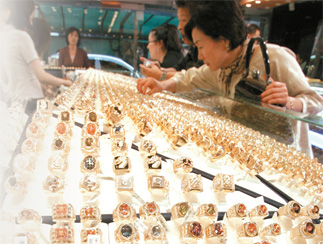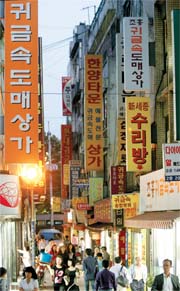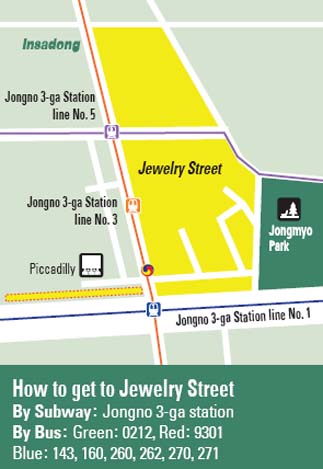Glitter and gold fill the streets of the Jongno district

Along that stretch of the bustling main artery downtown that is Jongno, visitors are treated to clusters of jewelry stores displaying gold and silver rings, earrings, necklaces and pendants.
Most of the stores are on ground level but some are two-story wonderlands filled with displays of precious stones and metals.
Everywhere on the street signs beckon: “Jewelry.”
In one of the stores, Kim Young-min, a 26 year-old college student, was busy looking at items in glass cases. “I’m trying to buy a ‘couple ring’ to celebrate the 100 days I have been dating my girlfriend,” he explained.
The rings Kim was browsing through retailed for 200,000 to 300,000 won.
“Nowadays, many of our customers are young couples celebrating some sort of special event like the 100th-day or one-year anniversary of a relationship” said Lee Hwang-jae, who has worked in the industry for over 30 years with his wife.
“Young people in their 20s and 30s make up most of our customers, around 70 percent,” Lee said.
“The jewelry we sell appeals to young people because of their trendy designs and low prices. Items here are about 30 percent cheaper than those sold in department stores.”
“The Jongno area in the past wasn’t filled with jewelry stores as it is today,” said Oh Hyo-keun, chairman of the Korea Jewelry Gem Association.

An alley behind the main Jongno street is congested with neon signs that read “jewelry wholesale.” Jongno has been teeming with jewelry stores since 1988. By Oh Sang-min
It was only after the Seoul Olympic in 1988 that the streets started filling up with stores selling gold, sliver and jade. The nation’s economy was booming and more and more people could afford jewelry and other luxury items. Jewelry manufacturers and retailers from other areas including Myeongdong and Namdaemun, started to move to Jongno as customers flocked in.
“Another strong point of Jongno at the time was that the rent was cheaper than in Myeongdong or in Namdaemun,” Oh said. “And there was space for stores.”
Most of the stores along the streets are wholesalers and retailers. But in the maze-like back alleys there are numerous small repair shops and jewelry makers as well.
According to the association, there are approximately 2,450 jewelry manufacturers nationwide and 1,333 wholesale and retailers. In Jongno alone there are 1,146 wholesalers and retailers, making up a large majority of the country’s jewelry market.

“The market is now polarized,” Oh said. “Those who wish to buy high-end jewelry foreign brands, such as Tiffany’s, purchase their goods at department stores while more practical customers who don’t put too much emphasis on brand names come to Jongno.”
To counter foreign luxury brands, 10 jewelry stores along with the jewelry gem association have teamed up to create a joint brand.
“By technique, Korean jewelry is as good as foreign brands,” Oh said. “However, the weaknesses of Korea’s jewelry industry are marketing and design.”
With financing from the Small and Medium Business Administration, the brand is expected to be unveiled in December.
Also to promote the jewelry district, a three-day festival is scheduled to be held starting Oct. 23.
The festival, which is celebrating its third year, includes both an auction and a jewelry fashion show.
“Customers will be able to purchase quality items that will be priced as much as half off,” said Oh Geun-sun, who is in charge of the 2008 Jewelry Festival.
Food and beverages as well as Korean games such as a yut tournament will be available during the festival.
Another threat faced by many of the stores in Jongno today are the changing looks and tastes of its customers.
“In the past, most of our customers were people in their 30s, 40s and older” Lee Hwang-jae said. “They were economically well off and could afford pricey jewelry. Today, customers tend to be younger and want to buy only inexpensive jewelry.”
This trend has been evident since the early 1990s when the so-called “couple ring” worn by young couples came into fashion, Lee said.
The downside for the industry: Products bought by young people aren’t as profitable as those bought by older people.
Other cultural changes are affecting the market.
Traditionally in Korea those invited to a child’s first birthday party usually gave a golden ring as present. “People today tend to give cash or some fashionable clothes,” said Oh.
“It’s cheaper to give a cash gift.”
“People don’t see jewelry as something of a necessity and therefore spend less when the economy is bad,” said Ahn Seon-shik.
Ahn not only manufactures pendants but also sells them in one of the stores in Jongno. He has been working in the jewelry business for over 20 years after leaving Iksan, North Jeolla, to seek his fortune in Seoul.
Ahn says most of his work and that of others mostly draw on ideas of foreign luxury brands.
Showing off a gold pendant with a word that reads almost like “Chanel” he said, “It’s hard to come up with original ideas and many customers still prefer jewelry items that somehow carries a semblance of foreign luxury.”
Ahn said most Koreans prefer jewelry - rings, pendant or necklaces - where gold plate is visible. However, compared with Western design, Ahn said Korean jewelry is more delicate and detailed.
By Lee Ho-jeong Staff Reporter [ojlee82@joongang.co.kr]










with the Korea JoongAng Daily
To write comments, please log in to one of the accounts.
Standards Board Policy (0/250자)